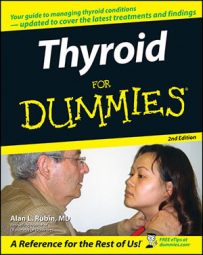Severe hyperthyroid eye disease, though rare, can lead to blindness. Just exactly why hyperthyroid eye disease occurs isn't clear, but researchers generally believe that it has a basis as an autoimmune disorder. One suggestion is that thyroglobulin enters the muscles of the eyes, and antibodies react against it. A study from Italy in the journal Thyroid in 2001 showed that thyroglobulin can, indeed, be found in the muscle tissue of the eyes. The study demonstrated that the thyroglobulin originated in the thyroid gland, which confirms that the autoimmune reaction in the thyroid is very similar to the autoimmune reaction in the eyes. The findings of the study help bolster the argument in favor of using anti-immunity therapy for hyperthyroid eye disease.
Hyperthyroid eye disease has a very negative impact on quality of life, even when it's moderate, which is usually the case. Severe eye disease occurs less than 5 percent of the time, but treatment works in only two-thirds of patients. The eye disease goes through three phases:
- First phase: High activity with redness of the eye, pain, tearing, and sensitivity to light.
- Second phase: Stabilization of the signs and symptoms.
- Final phase: Improvement of the eye disease, which becomes inactive.
The duration of these phases varies, but the eye disease burns out within a couple of years. Steroids are helpful during the first active phase.
Steroids given intravenously are more effective than steroids by mouth for thyroid eye disease. Steroids can be injected right into the muscles around the eye and are effective there. Doctors give IV steroids in very high amounts, which can cause liver damage. IV steroids are effective about 90 percent of the time, while liver damage occurs only 1 percent of the time.
If steroids aren't successful, then doctors perform orbital radiation therapy. This therapy is successful about 60 percent of the time. Using both steroids and orbital radiation at the same time is even better than either alone.
Recent studies of other therapies, including drugs called somatostatin analogs and antioxidants, haven't shown that these therapies are effective. Antioxidants may be useful for mild eye disease but not moderate or severe forms.
Three factors are definitely important in the progression of hyperthyroid eye disease, and should be managed as strongly as possible:
- Cigarette smoking: Cigarette smoking not only promotes the development of eye disease but blocks the effectiveness of steroid and orbital–radiation therapy treatments. Quitting smoking is probably the most important preventive measure in this disease.
- Active thyroid dysfunction: Active thyroid dysfunction, whether hyperthyroidism or hypothyroidism, promotes the progression of eye disease. Both conditions need to be corrected as soon as possible.
- Radiation therapy: This hyperthyroidism treatment causes progression of the eye disease as well. A course of steroids can prevent this progression.

